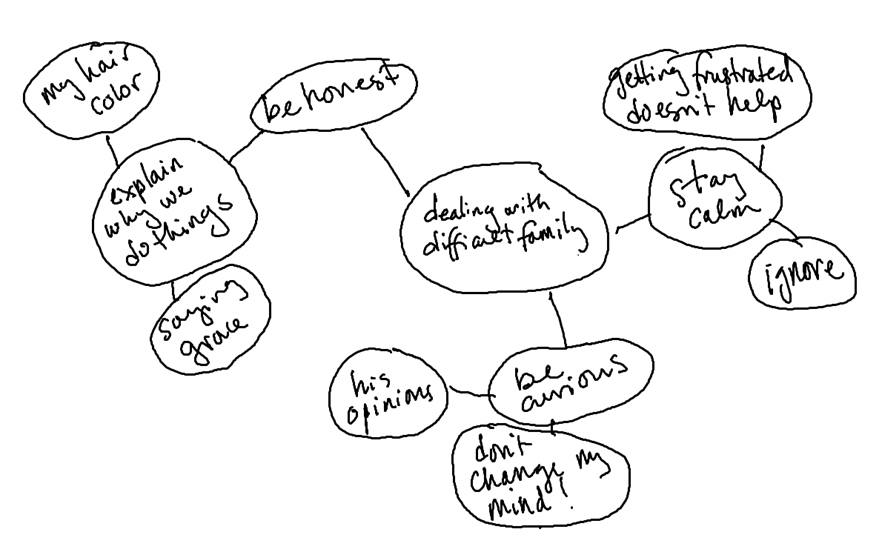4 Chapter Four: Exploring and Finding a Topic

Some people are lucky. When confronted with a writing task, they jump right in, tapping away at their keyboards or scribbling notes on their notebook pages, generating ideas without, it seems, a second thought. They’re the “chatty ones” of the writing world (in the best possible way, of course), typing away, while you sit by, staring at your blank page, wracking your brain and pulling out your hair, watching jealously as their sentences turn into paragraphs that turn into pages and pages.
We’ve all been there. Sometimes it’s obvious what to write about, but many times it’s not. Even if a topic seems clear, we might be missing out on an even better one because we get stuck on our initial idea. Sometimes we think our ideas are wrong; no one would want to read what we have to say. Sometimes we get a writing assignment and get paralyzed by the length. I have to write seven pages? You might think: There’s nothing I could write on for seven pages. This is going to be a disaster!
Okay, stop.
You cannot let your internal editor take control this early in the process. In fact, your inner critic needs to step off until you get to editing. At this point, you should relax your brain and get it into a place of open curiosity: instead of being paralyzed by the endless possibilities, be excited by those possibilities, and know that you’ll be able to find topics and points to make within those topics that will lead to solid writing.
You can do it! There are several ways of getting started:
Brainstorming
Brainstorming is a classic method of getting as many ideas out as possible while avoiding all  judgment of those ideas. Explore first because it’s entirely natural: as soon as you get a writing assignment, your brain is flipping through ideas, even if you aren’t consciously aware of it. When brainstorming, you’re doing the same thing as running through ideas in your mind, only you’re writing them down as you think of them.
judgment of those ideas. Explore first because it’s entirely natural: as soon as you get a writing assignment, your brain is flipping through ideas, even if you aren’t consciously aware of it. When brainstorming, you’re doing the same thing as running through ideas in your mind, only you’re writing them down as you think of them.
How you brainstorm will depend on the type of writing assignment you’re given. Let’s say you’ve been assigned an informative essay on any topic. That’s probably the most open writing assignment you can be given, and this kind of assignment can be paralyzing: there are too many choices! Don’t worry. Instead, brainstorm. Give yourself five minutes to write down whatever comes into your mind. It might look something like this:
Things I know a lot about
Raising dogs and iguanas
Budgeting
Netflix and Hulu
Being a certified nursing assistant
Bus routes
Living in an apartment building with noisy neighbors
Buying a house
Snapchat
Photography
Making Thanksgiving dinner
Killing houseplants
Maintaining a good relationship with family members who can drive me crazy
Doing laundry
Motivating myself to work out
These topics are random, yes, and many of them are also personal, but note how you could take a topic like, “Maintaining good relationships with family members who can drive me crazy” and make it broadly applicable to an outside audience. Who doesn’t have a family member who is irritating but unavoidable? This topic probably also has some great stories that go with it, too.
What about the topic “Killing houseplants”? Something like “Killing houseplants” is surely funny, but you could broaden that idea to be a tongue-in-cheek essay about how to NOT do simple things well. Thus, the practical and visible picture of killing houseplants can be written about to make a statement about life more broadly: how to not do simple things well in all aspects of life. For example, getting a job making change in a booth in a parking lot, but doing a bad job at it because you can’t stop writing your novel in a notebook you bring to work with you. The point? Sometimes doing simple things poorly can actually lead to better things.
Brainstorming also works when you are given a focused topic. Let’s say you’re tasked with writing about conventional versus organic farming. You’re not particularly interested in the topic, but there it is: you must write about it.
Example of brainstorm for a writing assignment
Conventional versus organic farming:
- Who is most interested in organic farming?
- Who is most interested in conventional farming?
- What does conventional farming even mean? How about organic?
- GMOs have something to do with this
- The local co-op might have some ideas about organics
- I’ve seen organic stuff in the regular grocery stores. I wonder how the co-ops feel about that.
- Organics are more expensive
- Organics are healthier, maybe?
- Is this just about produce, or is it about meat and grains?
- If I buy food at the farmer’s market, is it organic or conventional?
- Interview the farmer family down the road?
What’s happening here is a lot of questioning, which is great. It’s showing what the writer is curious about the topic, and it also shows some gaps in knowledge where the writer might need to do some research.
Beware of the tendency to want to take on every item in a brainstormed list of ideas. In the farming example above, yes, all the brainstormed items are related to the topic, but an essay explaining every one of those would look more like a book. Just one of those topics, like organics in traditional grocery stores, might be enough to write an essay. In fact, when you’ve landed on a specific aspect of the topic, you could brainstorm again for even more specific ideas on the topic.
Once you’ve carefully considered your audience, you will be able to narrow your topic or do some more specific and detailed brainstorming. For example, what if you need to write about organic versus conventional farming and the audience is your boss and his work group? Brainstorm that.
It also might be time to turn to freewriting.
Freewriting
Freewriting is just that: free writing. All it costs you is some time. Freewriting allows you to generate text quickly, without judgment, on a specific topic. You’ll tend to write in complete sentences in freewriting, but you don’t need to edit or proofread. So, if there are misspelled or misused words, that’s fine. If you have fragment sentences, that’s okay too. You must turn off your internal editor to let your ideas flow.
When you have your topic, set your timer (five to ten minutes is plenty to start) and let your pen or fingers fly.
Let’s focus on the topic of relationships with annoying family members. A five-minute freewrite on that topic might look something like this:
Freewriting example: How to get along with annoying family members
I find thanksgiving and Christmas to be the worst when it comes to getting along with my uncle Marcus. He is always bothering me about how I look because he doesn’t like my nose piercing or he hates my hair color, like last Christmas when it was purple he wouldn’t stop calling me a purple people eater and it was so annoying. He also talks about politics all the time and makes fun of us when we say grace before the meal, which I think is really disrespectful. I’ve talked to my mom and dad about it but they say he’s family so he will always be welcome and that I need to learn how to get along with him or just ignore him. He’s hard to ignore so I’ve figured out some ways to deal with him.
When he talks about how I look I just say that it’s my choice and I’m happy with how I look. I’ve said that same thing over and over to him. My message doesn’t change. Which has seemed to make a difference because I’m not playing into his drama. I’m calm. That calmness also works with the political stuff. I used to get so mad when he’d say stuff I didn’t agree with and keep pushing his ideas. But then I decided to try to figure out why he feels that way. It doesn’t make a difference in how I feel about the issue but if I’m just like, “oh yeah, so why do you feel like that?” it gets him talking in a more reasonable and less annoying way. And when we say grace and he makes fun of it I either ignore him or I have said before, “this is something we do because it is good to be grateful even if you don’t believe in god” and he was kind of surprised by that and didn’t say anything anymore.
First, that’s a lot of text! Second, there are a lot of great ideas in there that could be expanded into advice, like the part about becoming curious about the uncle’s extreme political views rather than being immediately insulted by them. That could easily be expanded into a full paragraph.
Is the freewrite kind of messy and are there errors? Yes, and yes, but the freewrite has also gotten solid ideas down on the page that wouldn’t be there otherwise.
In five minutes, this writer has a great start and can now consider audience and purpose to help focus the ideas even more.
Mind Mapping
Another method for exploration goes by many names: mind mapping, mapping, clustering, etc. This is a visual way of seeing the connections between your ideas and organizing them. To start, you put the topic in the center of the page and draw a circle around it.
Then you can add other details, drawing circles around those and lines of connection:

The mind map can then act as a sort of outline for your essay. Seeing those connections in this visual way shows where you might need more detail or examples, and you can then take those ideas to organize into body paragraphs.
The writer’s notebook
Many authors who get paid for their work keep notebooks filled with their ideas. Like a traditional journal, as ideas occur to them, as they see or hear interesting things throughout their days or find snippets of material as they’re reading other work, they record it in a notebook. Sometimes their notebook is a traditional bound paper book, but technology has allowed writers to do this digitally, too. Some utilize a smartphone’s camera, and others use apps like Evernote to archive material as they find it. Many people just use a notes app on their phone.
The point is to be open to topic possibilities all around you and capture them in real time to refer to later.
Additional Advice for Finding a Topic
The best advice for exploring: If you’re not sure what to write about, and the writing assignment is open-ended, consider two things: your passion and your personal experience.
Brainstorm as many answers as possible for these questions and you’ll have many possible topic choices, or freewrite on them, each for a short time, and compare what you come up with—find the best, which is often the one you’ve written the most about. In the end, however, you will decide where to go based on your audience and purpose.
You might be tempted to ask Generative Artificial Intelligence for ideas, but use your own brain first. You might think you don’t have anything to write about, but you do: you have so many things to say about yourself and the world.
Media Attributions
- explorer © Designed by slidesgo / Freepik
- Lightbulb with ideas © Adobe Stock Images
- mind map © Kelli Hallsten Erickson
A method of generating ideas by writing down everything that comes to mind without judgment.
A technique where you write continuously for a set period without worrying about grammar or structure to generate ideas.
A visual brainstorming tool that helps organize ideas and show connections between them.
The specific subject or issue that a writer focuses on and explores in an academic paper.
